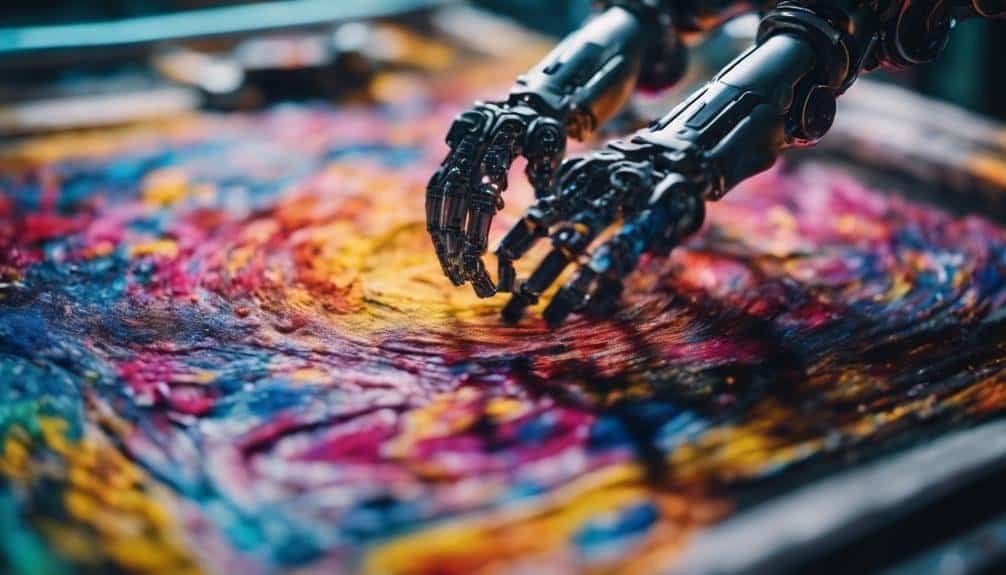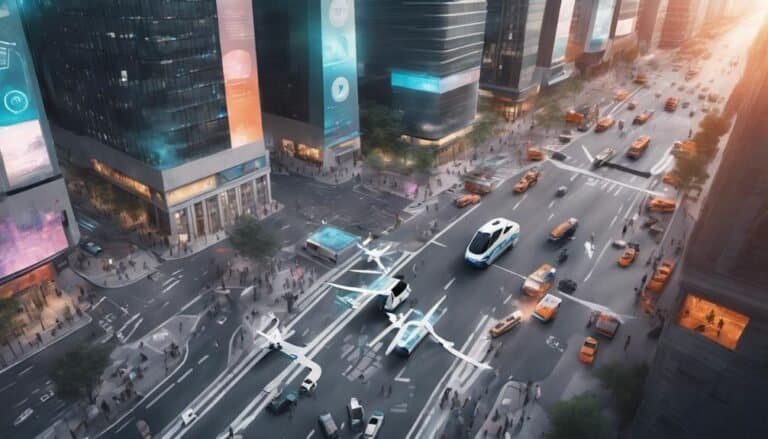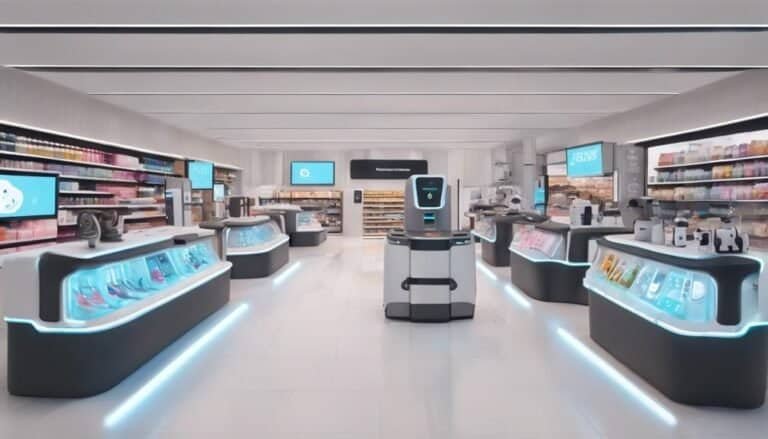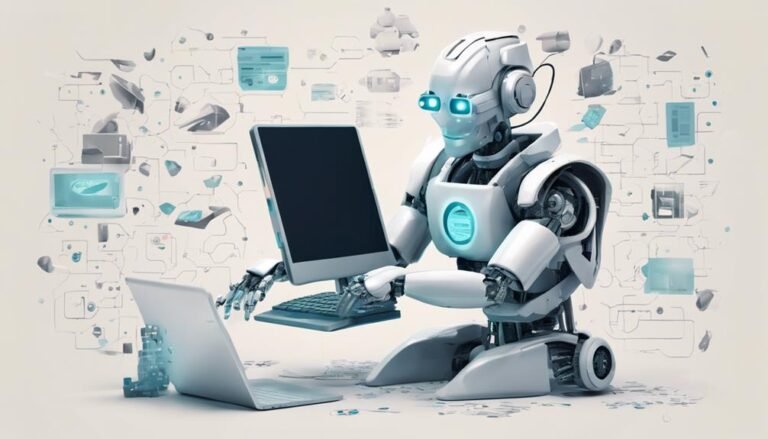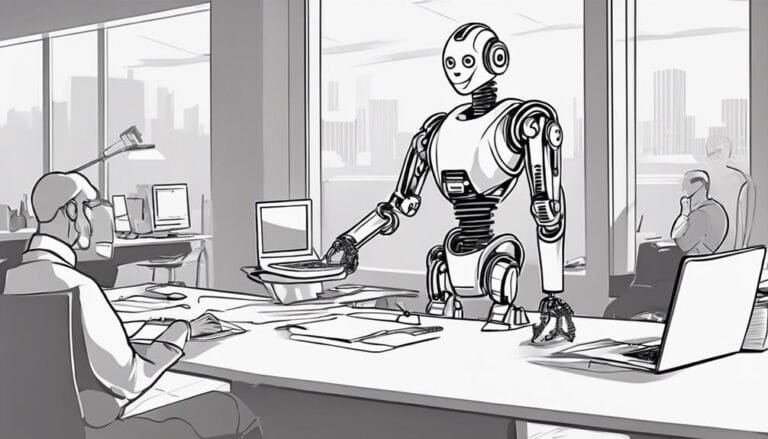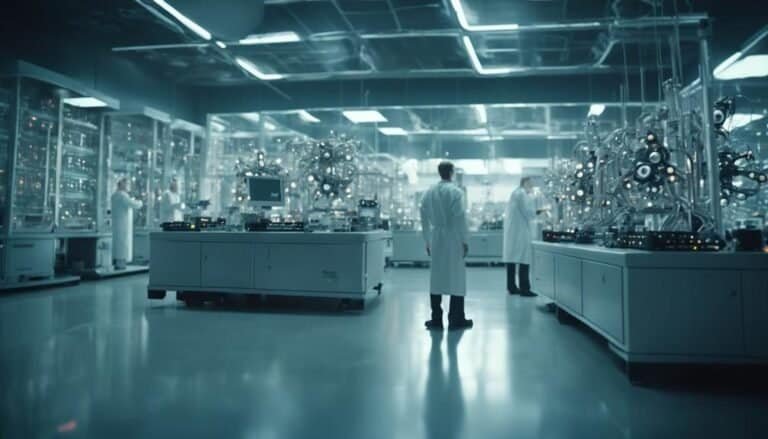The Intersection of AI and Art: A New Creative Paradigm
In the realm of artistic expression, the convergence of artificial intelligence (AI) and art has sparked a profound shift in the creative landscape. As AI continues to evolve, its integration into the world of art has raised intriguing questions about the essence of creativity, the boundaries of human ingenuity, and the very nature of artistic creation itself.
This fusion of technology and artistic endeavor has not only challenged conventional notions of artistry but has also opened up a realm of uncharted possibilities that beckon exploration into uncharted territories of innovation and imagination.
Key Takeaways
- AI in art expands creative boundaries and fosters innovative collaborations.
- AI-generated artworks offer unique interactive experiences to audiences.
- AI transforms traditional art techniques by blending human creativity with technological tools.
- Ethical considerations in AI art challenge notions of authorship and ownership, requiring transparency and accountability.
The Rise of AI in Art
The incorporation of artificial intelligence (AI) into the realm of art has marked a significant shift in the creative landscape, revolutionizing traditional artistic processes and opening up new possibilities for artistic expression. AI creativity, a term coined to describe the ability of AI systems to generate novel and imaginative outputs, has been instrumental in pushing the boundaries of artistic innovation.
Artists and technologists are increasingly collaborating to explore the potential of AI as a tool for creativity, leading to the development of new art forms and approaches that were previously unimaginable.
One key aspect of AI creativity is its capacity to analyze vast amounts of data and identify patterns that can inspire unique artistic creations. By leveraging machine learning algorithms, artists can harness AI to generate complex visualizations, music compositions, and even poetry. This fusion of technology and artistry has paved the way for a new wave of artistic innovation, challenging conventional notions of authorship and pushing the boundaries of human creativity.
As AI continues to evolve, its impact on the art world is likely to deepen, offering new avenues for exploration and experimentation.
AI-Generated Artworks and Installations
Exploring the intersection of artificial intelligence with artistic creation, AI-generated artworks and installations exemplify the fusion of technology and creativity in redefining traditional artistic processes. These generative creations push boundaries by leveraging complex algorithms to produce art that challenges conventional norms.
Here are some key points to consider:
- Innovative Techniques: AI-enabled tools allow artists to explore new techniques and styles that were previously inaccessible, leading to avant-garde creations.
- Interactive Experiences: AI-generated artworks often offer interactive experiences, blurring the lines between the creator, the art piece, and the audience.
- Unpredictable Outcomes: The nature of AI algorithms can result in unexpected outcomes, fostering a sense of spontaneity and uniqueness in the art world.
- Cross-disciplinary Collaboration: AI encourages collaboration between artists, technologists, and scientists, opening up new possibilities for interdisciplinary projects.
- Challenging Perceptions: AI-generated installations challenge traditional notions of authorship and creativity, sparking debates on the essence of art in the digital age.
AI as a Collaborator in Art
Utilizing artificial intelligence as a collaborative tool in the realm of art heralds a paradigm shift in creative processes, introducing novel methods of expression and exploration. AI collaboration in art opens up exciting possibilities for artists to push the boundaries of their creativity and engage in new forms of artistic innovation. By partnering with AI systems, artists can co-create artworks that blend human imagination with the computational power of machines, resulting in unique and cutting-edge pieces.
The table below highlights some key aspects of AI collaboration in art:
| Benefits of AI Collaboration | Examples |
|---|---|
| Enhances creative potential | Google's Magenta Project |
| Expands artistic horizons | The Next Rembrandt Project |
| Facilitates experimentation | AiDA – AI Drawing Assistant |
| Encourages interdisciplinary work | DeepDream by Google |
| Fosters innovation | AI-generated music compositions |
AI as a collaborator in art not only challenges traditional artistic methods but also paves the way for a new era of artistic exploration and expression. This fusion of human creativity with artificial intelligence promises to redefine the boundaries of what is possible in the realm of art.
Transforming Traditional Art Techniques
Transforming conventional art methodologies through integration of cutting-edge technology presents a groundbreaking approach to artistic evolution and advancement. Artists are now exploring new horizons by incorporating digital brushstrokes and automated compositions into their creative processes. This fusion of traditional techniques with modern tools is reshaping the art landscape and pushing boundaries like never before.
- Enhanced Creativity: Technology enables artists to experiment with new styles and techniques, fostering a more innovative approach to art creation.
- Efficiency in Workflow: Automated tools streamline the artistic process, allowing for quicker iterations and experimentation.
- Precision and Consistency: Digital brushstrokes offer artists the ability to achieve a level of precision and consistency that was previously unattainable.
- Exploration of New Aesthetics: Automated compositions open doors to exploring unique aesthetic possibilities that challenge traditional artistic norms.
- Collaboration with AI: Artists can now collaborate with AI algorithms to generate art pieces that blend human creativity with machine intelligence seamlessly.
Ethical Considerations in AI Art
Artificial intelligence's integration into the realm of art has brought to light a myriad of ethical considerations that necessitate critical examination and thoughtful deliberation. As AI becomes more prevalent in the creation and curation of art, various ethical dilemmas and moral implications arise, challenging traditional notions of authorship, creativity, and originality. One of the key ethical dilemmas is the issue of attribution and ownership. Who should be credited as the creator when AI systems generate artworks autonomously? This raises questions about intellectual property rights and the fair compensation of human artists involved in the AI art creation process.
To provide a clearer perspective, let's delve into a table highlighting some of the primary ethical considerations in AI art:
| Ethical Considerations | Description | Impact |
|---|---|---|
| Attribution and Ownership | Determining credit and rights for AI-generated art | Artist recognition and compensation may be compromised |
| Bias and Discrimination | AI algorithms may perpetuate societal biases | Reinforcement of harmful stereotypes and inequalities |
| Transparency and Accountability | Understanding how AI creates art | Ensuring responsible and ethical use of AI in art projects |
These ethical considerations underscore the need for ongoing discussions and frameworks to address the evolving landscape of AI art and its ethical implications.
Redefining the Role of the Artist
The integration of AI in art creation is reshaping the traditional role of artists by introducing new dimensions of creativity and collaboration.
Artists are now leveraging technology to enhance their creative process, blurring the lines between human ingenuity and artificial intelligence.
This shift signifies a paradigmatic change in how art is conceived, produced, and experienced in the contemporary landscape.
Artist's Evolving Role
In the realm of artistic creation, the evolving role of the artist is undergoing a profound redefinition in the era of AI integration and technological advancements. As artists navigate this new landscape, several key aspects are reshaping the traditional notions of artistic practice:
- Collaborative Innovation: Artists are engaging in partnerships with AI systems to explore new realms of evolving creativity.
- Hybrid Art Forms: The boundaries between traditional art and technology are blurring, leading to the creation of innovative hybrid art forms.
- Data-Driven Insights: Artists are utilizing AI-generated data to gain deeper insights into their creative process.
- Interactive Experiences: The role of the artist is shifting towards creating interactive experiences that engage with AI technologies.
- Ethical Considerations: The evolving role of the artist raises ethical questions regarding authorship, creativity, and the impact of AI on artistic expression.
Tech-Infused Creative Process
Navigating the intersection of technology and creativity, artists are revolutionizing their roles through a tech-infused creative process. AI integration has become a cornerstone in this paradigm shift, enabling artists to explore new realms of creative exploration.
By incorporating artificial intelligence into their workflow, artists can leverage advanced algorithms to generate innovative ideas, enhance their artistic vision, and push the boundaries of traditional art forms. This fusion of technology and creativity allows artists to break free from conventional constraints, unlocking new possibilities for artistic expression and experimentation.
As artists embrace AI integration in their creative process, they redefine the role of the artist as a visionary who collaborates with technology to craft unique and compelling works of art.
Future Implications and Possibilities
As we delve deeper into the realm of AI and its intersection with art, the horizon of future implications and possibilities appears boundless. The fusion of artificial intelligence and artistic endeavors is paving the way for unprecedented advancements and transformations in the creative landscape.
Some of the potential applications and artistic innovations that we can anticipate include:
- AI-Generated Art: The creation of artworks generated entirely by AI algorithms, blurring the lines between human and machine creativity.
- Enhanced Creativity Tools: AI-powered tools that assist artists in ideation, design, and execution, revolutionizing the creative process.
- Personalized Art Experiences: Tailored artistic experiences for individuals based on their preferences, emotions, and biometric data.
- Collaborative Art Projects: Facilitation of collaborative projects between artists and AI systems, leading to unique and groundbreaking artworks.
- Ethical Considerations: Addressing ethical concerns surrounding AI-generated art, intellectual property rights, and the role of AI in shaping artistic expression.
The future holds a realm of possibilities where AI and art converge to redefine creativity, expression, and artistic experiences.
Conclusion
In conclusion, the intersection of AI and art presents a unique and innovative creative paradigm that challenges traditional notions of artistic creation. As AI continues to evolve and expand its capabilities, the possibilities for collaboration and exploration in the art world are endless.
However, the ethical considerations surrounding AI-generated art must be carefully navigated to ensure the integrity and authenticity of artistic expression. The future implications of this fusion of technology and creativity are both exciting and potentially transformative.

